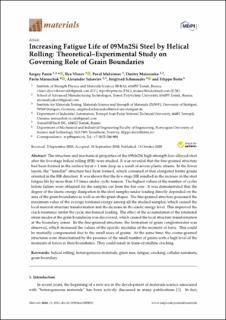| dc.contributor.author | Panin, Sergey | |
| dc.contributor.author | Vlasov, Ilya | |
| dc.contributor.author | Maksimov, Pavel | |
| dc.contributor.author | Moiseenko, Dmitry | |
| dc.contributor.author | Maruschak, Pavlo | |
| dc.contributor.author | Yakovlev, Alexander | |
| dc.contributor.author | Schmauder, Siegfried | |
| dc.contributor.author | Berto, Filippo | |
| dc.date.accessioned | 2022-05-10T08:00:53Z | |
| dc.date.available | 2022-05-10T08:00:53Z | |
| dc.date.created | 2020-12-17T09:58:24Z | |
| dc.date.issued | 2020 | |
| dc.identifier.citation | Materials. 2020, 13 (20), 1-29. | en_US |
| dc.identifier.issn | 1996-1944 | |
| dc.identifier.uri | https://hdl.handle.net/11250/2994953 | |
| dc.description.abstract | The structure and mechanical properties of the 09Mn2Si high-strength low-alloyed steel after the five-stage helical rolling (HR) were studied. It was revealed that the fine-grained structure had been formed in the surface layer ≈ 1 mm deep as a result of severe plastic strains. In the lower layers, the “lamellar” structure had been formed, which consisted of thin elongated ferrite grains oriented in the HR direction. It was shown that the five-stage HR resulted in the increase in the steel fatigue life by more than 3.5 times under cyclic tension. The highest values of the number of cycles before failure were obtained for the samples cut from the bar core. It was demonstrated that the degree of the elastic energy dissipation in the steel samples under loading directly depended on the area of the grain boundaries as well as on the grain shapes. The fine-grained structure possessed the maximum value of the average torsional energy among all the studied samples, which caused the local material structure transformation and the decrease in the elastic energy level. This improved the crack resistance under the cyclic mechanical loading. The effect of the accumulation of the rotational strain modes at the grain boundaries was discovered, which caused the local structure transformation at the boundary zones. In the fine-grained structure, the formation of grain conglomerates was observed, which increased the values of the specific modulus of the moment of force. This could be mutually compensated due to the small sizes of grains. At the same time, the coarse-grained structures were characterized by the presence of the small number of grains with a high level of the moments of forces at their boundaries. They could result in trans-crystalline cracking. | en_US |
| dc.language.iso | eng | en_US |
| dc.publisher | MDPI | en_US |
| dc.rights | Navngivelse 4.0 Internasjonal | * |
| dc.rights.uri | http://creativecommons.org/licenses/by/4.0/deed.no | * |
| dc.title | Increasing Fatigue Life of 09Mn2Si Steel by Helical Rolling: Theoretical–Experimental Study on Governing Role of Grain Boundaries | en_US |
| dc.title.alternative | Increasing Fatigue Life of 09Mn2Si Steel by Helical Rolling: Theoretical–Experimental Study on Governing Role of Grain Boundaries | en_US |
| dc.type | Peer reviewed | en_US |
| dc.type | Journal article | en_US |
| dc.description.version | publishedVersion | en_US |
| dc.source.pagenumber | 1-29 | en_US |
| dc.source.volume | 13 | en_US |
| dc.source.journal | Materials | en_US |
| dc.source.issue | 20 | en_US |
| dc.identifier.doi | 10.3390/ma13204531 | |
| dc.identifier.cristin | 1860870 | |
| cristin.ispublished | true | |
| cristin.fulltext | original | |
| cristin.qualitycode | 1 | |

